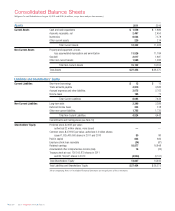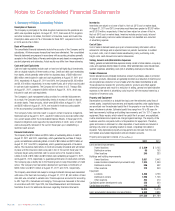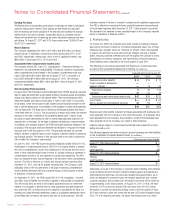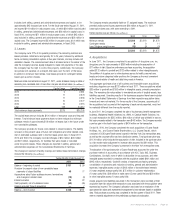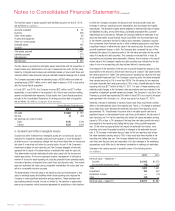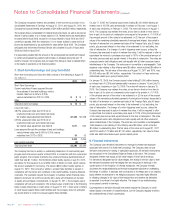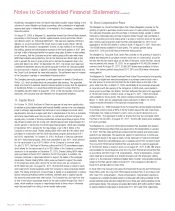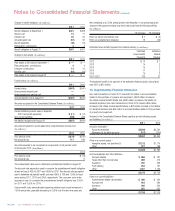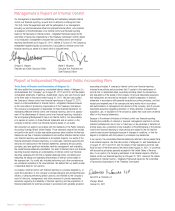Walgreens 2011 Annual Report Download - page 37
Download and view the complete annual report
Please find page 37 of the 2011 Walgreens annual report below. You can navigate through the pages in the report by either clicking on the pages listed below, or by using the keyword search tool below to find specific information within the annual report.
Fair Value Hedges
For derivative instruments that are designated and qualify as fair value hedges,
the gain or loss on the derivative, as well as the offsetting gain or loss on the
hedged item attributable to the hedged risk, are recognized in interest expense
on the Consolidated Statement of Earnings.
In January 2010, the Company terminated its existing one-month future LIBOR
swaps that converted $1,300 million of its 4.75% fixed rate debt to floating. Upon
termination, the Company received payment from its counterparty that consisted of
accrued interest and an amount representing the fair value of the swaps. The related
fair value benefit attributed to the Company’s debt continues to amortize over the
life of the debt, which matures on August 1, 2013. The Company then entered into
six-month LIBOR in arrears swaps with two counterparties.
In May 2011, the Company entered into interest rate swaps with two counterparties
converting $250 million of its 5.25% fixed rate notes to a floating interest rate
based on the six-month LIBOR in arrears plus a constant spread. The swap
termination date coincides with the notes maturity date, January 15, 2019.
The notional amounts of derivative instruments outstanding at August 31, 2011
and 2010, were as follows (In millions):
2011 2010
Derivatives designated as hedges:
Interest rate swaps $ 1,550 $ 1,300
The changes in fair value of the notes attributable to the hedged risk are included
in long-term debt on the Consolidated Balance Sheets (see Note 7) and amortized
through maturity. At August 31, 2011 and 2010, the Company had net unamortized
fair value changes of $57 million and $51 million, respectively.
The fair value and balance sheet presentation of derivative instruments at August 31,
2011, were as follows (In millions):
Location in
Consolidated Balance Sheet 2011 2010
Asset derivatives designated as hedges:
Interest rate swaps Other non-current assets $ 63 $ 44
Gains and losses relating to the ineffectiveness of the Company’s derivative instru-
ments are recorded in interest expense on the Consolidated Statement of Earnings.
The Company recorded a $1 million gain in both fiscal years 2011 and 2010.
9. Fair Value Measurements
The Company measures its assets and liabilities in accordance with ASC Topic 820,
Fair Value Measurements and Disclosures. ASC Topic 820 defines fair value as the
price that would be received for an asset or paid to transfer a liability in an orderly
transaction between market participants on the measurement date. In addition, it
establishes a fair value hierarchy that prioritizes observable and unobservable inputs
used to measure fair value into three broad levels:
Level 1 – Quoted prices in active markets that are accessible at the measurement
date for identical assets and liabilities. The fair value hierarchy gives the
highest priority to Level 1 inputs.
Level 2 – Observable inputs other than quoted prices in active markets.
Level 3 – Unobservable inputs for which there is little or no market data available.
The fair value hierarchy gives the lowest priority to Level 3 inputs.
Assets and liabilities measured at fair value on a recurring basis were as follows
(In millions) :
August 31, 2011 Level 1 Level 2 Level 3
Assets:
Money market funds $ 1,239 $ 1,239 $ — $ —
Interest rate swaps 63 — 63 —
August 31, 2010 Level 1 Level 2 Level 3
Assets:
Money market funds $ 1,030 $ 1,030 $ — $ —
Interest rate swaps 44 — 44 —
Interest rate swaps are valued using six-month LIBOR in arrears rates.
See Note 8 for additional disclosure regarding financial instruments.
Assets measured at fair value on a non-recurring basis were as follows
(In millions) :
August 31, 2010 Level 1 Level 2 Level 3
Assets:
Goodwill $ 3 — — $ 3
Goodwill for the Company’s Long-Term Care Pharmacy with a carrying value of
$19 million was written down to its implied fair value of $3 million in fiscal year
2010. The impairment resulted in a $16 million charge and added a $6 million
deferred tax asset. The determination of fair value was based on an asset sale
agreement with Omnicare, Inc., which was signed on August 31, 2010.
See Note 5 for further discussion on the impairment.
The Company reports its debt instruments under the guidance of ASC Topic 825,
Financial Instruments, which requires disclosure of the fair value of the Company’s
debt in the footnotes to the consolidated condensed financial statements.
10. Commitments and Contingencies
The Company is involved in legal proceedings, including those described below, and is
subject to investigations, inspections, audits, inquiries and similar actions by govern-
mental authorities, arising in the normal course of the Company’s business. Litigation,
in general, and securities and class action litigation, in particular, can be expensive
and disruptive. Some of these suits may purport or may be determined to be class
actions and/or involve parties seeking large and/or indeterminate amounts, including
punitive or exemplary damages, and may remain unresolved for several years. The
results of legal proceedings are often uncertain and difficult to predict, and the costs
incurred in litigation can be substantial, regardless of the outcome.
On a quarterly basis, the Company assesses its liabilities and contingencies for
outstanding legal proceedings, including those described below, and reserves are
established on a case-by-case basis for those legal claims for which management
concludes that it is probable that a loss will be incurred and that the amount of such
loss can be reasonably estimated. Management’s assessment of our current litigation
and other legal proceedings, including the corresponding accruals, could change
because of the discovery of facts with respect to legal actions or other proceedings
pending against the Company which are not presently known. Adverse determinations
by judges, juries or other parties could also result in changes to management’s
assessment of current liabilities and contingencies. The ultimate costs of resolving
these claims may be substantially higher or lower than the amounts reserved.
Due to the inherent difficulty of predicting the outcome of litigation and other legal
proceedings, the Company cannot predict the eventual outcome of these matters,
and it is reasonably possible that some of them could be resolved unfavorably to the
Company. As a result, it is possible that the Company’s results of operations or cash
flows in a particular fiscal period could be materially affected by an unfavorable
resolution of pending litigation or contingencies. However, based on its current
2011 Walgreens Annual Report Page 35



